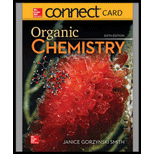
(a)
Interpretation: Hydrogen atoms with
Concept introduction: Acidic strength can be measured by a factor known as
(b)
Interpretation: Hydrogen atoms with
Concept introduction: Acidic strength can be measured by a factor known as
(c)
Interpretation: Hydrogen atoms with
Concept introduction: Acidic strength can be measured by a factor known as
Want to see the full answer?
Check out a sample textbook solution
Chapter 21 Solutions
ORGANIC CHEMISTRY-ACCESS
- d) Determine the formal charge on the nitrogen atom in each of the structures. NH3 NH2 N C бобкат : N N H H Н H2N-OH A B C D E F Garrow_forwardLewis Structure, Hybridization & Molecular Geometry a) Draw the Lewis Structure of the molecules; Label the hybridization of each carbon atom; Predict the approximate molecular geometry around each carbon atom. CH3CHO CH3CN b) Draw the Lewis Structure of Nitromethane; Predict the approximate molecular geometry around the nitrogen atom. CH3NO2 c) Draw the Lewis Structure; Label the hybridization of the boron atom; Predict the approximate molecular geometry. BF3 BF4arrow_forwarda. The structure of the bicarbonate (hydrogen carbonate) ion, HCO3-, HCO3 " is best described as a hybrid of several contributing resonance forms, two of which are shown here. HO :0: HO + :Ö: Bicarbonate is crucial for the control of body pH (for example, blood pH 7.4). A more self-indulgent use is in baking soda, where it serves as a source of CO2 CO2 gas, which gives bread and pastry their fluffy constituency. (i) Draw at least one additional resonance form. = (ii) Using curved "electron-pushing" arrows, show how these Lewis structures may be interconverted by movement of electron pairs. (iii) Determine which form or forms will be the major contributor(s) to the real structure of bicarbonate, explaining your answer on the basis of the criteria in Section 1-5.arrow_forward
- Calibri 11 + BIL NAME: Jaylena M A student is investigating the ctect of volume on pressure during a lab activity. The student uses the following volumes (mL). 12, 13, 14, 16, 17, 18, 19, 20, 21, 22, 23, 24, 26, 28, 30, 33, 34, 35, 38, 40, 42, 44. 46, and 50. As the volume changed they measured the following pressures (atm) 11.0, 10.5, 10.0, 9.2. 8.5, 78, 75, 7.0, 6.8, 6.5, 6.0, 5.9, 5.5, 5.0, 4.8, 4.5, 4.2, 3.9, 3.8, 3.5, 3.3, 3.2, 3.0, 2.9. What is the independent variable? Volume Imla What is the dependent variable? Pressure Jatm Use the data and make a PROPER data table. Volume 1mL) Pressure latm 110arrow_forwardDraw all resonance forms of the molecules. Include curved arrow notation. Label major resonance contributor.arrow_forward: Resonance Forms a) Draw all resonance forms of the molecules. Include curved arrow notation. Label major resonance contributor. SO₂ NO3arrow_forward
- 1d. Use Le Chatelier's principle to describe the effect of the following changes on the position of the Haber-Bosch equilibrium: N2(g) + 3H2(g)= 2NH3(9) AH = -92kJ Choose one of the following answers: shift to reactant side, shift to product side or no change and draw the resulting graph. I. Increase the [N2(g)] Effect: H₂ N₂ NH3 II. Decrease the volume of the container. Effect: H₂ N₂2 NH3arrow_forwardf) The unusual molecule [2.2.2] propellane is pictured. 1) Given the bond length and bond angles in the image, what hybridization scheme best describes the carbons marked by the askerisks? 2) What types of orbitals are used in the bond between the two carbons marked by the askerisks? 3) How does this bond compare to an ordinary carbon-carbon bond (which is usually 1.54 Å long)? CH2 1.60Å H₂C * H₂C CH2 C H2C * C Of H₂ 120°arrow_forwarde) Determine the hybridization and geometry around the indicated carbon atoms. H3C CH3 B HC CH2 A C C C CH3arrow_forward
 Chemistry: Matter and ChangeChemistryISBN:9780078746376Author:Dinah Zike, Laurel Dingrando, Nicholas Hainen, Cheryl WistromPublisher:Glencoe/McGraw-Hill School Pub Co
Chemistry: Matter and ChangeChemistryISBN:9780078746376Author:Dinah Zike, Laurel Dingrando, Nicholas Hainen, Cheryl WistromPublisher:Glencoe/McGraw-Hill School Pub Co Organic ChemistryChemistryISBN:9781305580350Author:William H. Brown, Brent L. Iverson, Eric Anslyn, Christopher S. FootePublisher:Cengage Learning
Organic ChemistryChemistryISBN:9781305580350Author:William H. Brown, Brent L. Iverson, Eric Anslyn, Christopher S. FootePublisher:Cengage Learning


